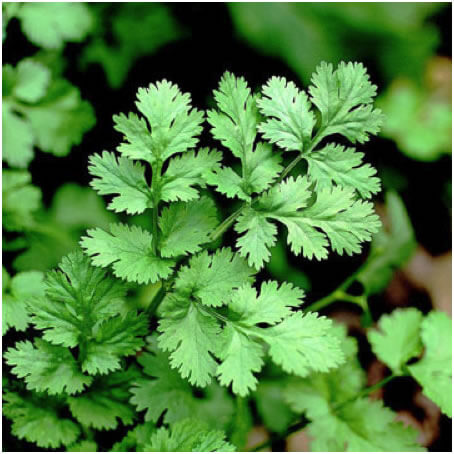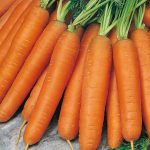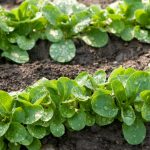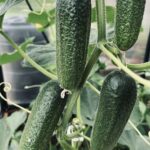Coriander – Green Thunder
€1.95
Description
Coriander – Green Thunder is becoming a very popular herb and this variety is specially selected for leaf production. Furthermore, if you buy plain coriander seeds they are likely to bolt much quicker. This is because the plants are meant for producing coriander seed.
Coriander is a short lived annual herb and therefore needs to be sown at regular intervals to ensure a continuous supply.
Sowing:
Sow in modular trays (5-7 seeds per cell) and plant out 4 weeks later.
Alternatively, you can sow seeds directly into a well prepared seedbed (2cm deep).
1. February to April for indoor planting.
2. April to July for outdoor planting.
3. August to October for indoor planting.
For a continuous supply sow at regular intervals (3-4 weeks).
Plant care:
Keep weed free and water when dry.
Harvesting:
The first pickings can be made from about 8 weeks after sowing. Use the cut and come again method. Cut when the plants are about 15cm tall.
Potential problems:
Fortunately, apart from bolting there is very little to worry about.
How much to grow?
Two to three multi-seeded plants of each sown every three weeks will be adequate.
Varieties:
Coriander – Green Thunder
Approx. seed count: 100sds
Further information about coriander:
Latin name:
Coriandrum satinum
Family:
Umbelliferae (also known as Apiaceae)
After parsley and basil, coriander is the third best selling herb. There are so many dishes where coriander is an essential ingredient. It is also such an amazingly fast and easy herb to grow. If you sow a small amount at regular intervals you can get coriander for ten months of the year. You have to ensure that you purchase seeds from a variety that is suitable for leaf production. Normal coriander seed (without a variety name) is better for seed production.
Soil and site
Coriander is such an easy plant to grow. Any reasonably fertile soil will do. It can even be grown in semi-shade.
Sowing
For continuity you can sow every two to three weeks from early February until mid September. The early sowings (February to late April) and late sowings (August to September) should be planted in a tunnel or greenhouse whereas the other sowings can be planted outdoors.
The very early sowings in February and March should be done in modular trays and placed on a heating bench at 18ºC. I generally sow a small pinch of seeds (about 5 –7) per cell. The seedlings are not divided when planted out about 4 weeks later.
When the soil has warmed sufficiently, seeds can be sown directly into a well prepared seed bed. Whichever method you use it is so important that the seed compost or seed bed does not dry out at any stage. If your seedlings suffer in the trays from a lack of water they start to panic and run into seed before they are even planted out. They also react like this if they are left for too long in the modules. You have to be careful that you plant the modules out before the plants get pot-bound. This is about three to four weeks after sowing.
Spacing
Between rows: 25cm
Between plants: 15cm (groups of 5-7 plants)
Plant care
It is important to keep coriander growing steadily otherwise it is very prone to bolting. This can be achieved by keeping the soil moist and the tunnel or greenhouse well ventilated.
Harvesting
With successional sowings you can expect to harvest coriander from late March until November. You can pick individual leaves if only small quantities are required.
Alternatively you can use the cut-and-come-again technique. When the plant is about 15cm tall you can cut the whole plant at about 5cm height from soil level. The leaves will regrow within a few weeks and you can repeat the cutting.
You can expect to get two to three good cuts per plant. As soon as the new batch is producing well it is best to discard the older ones.
Potential problems
Coriander is such a short-lived crop that very little can bother it. If it is well grown and not left for too long in the ground you should have no problem with it.
How much to grow?
You will get 24 plants (groups of 5-7) per square metre. Each group may yield up to 30g. Sowing 5 cells every two to three weeks should be adequate for a family’s needs.
History
As a spice, the lemony and floral flavor of coriander is in many Asian, Latin, and Indian dishes. It also is used widely in European cuisine. Whilst the leaves of the coriander plant are a herb, the round seeds are used to make coriander spice. This spice is also found in the Indian spice mixture garam masala. And this is also used in many savory dishes.
Coriander is a spice produced from the round, tan-colored seeds of the coriander plant. And it is a member of the parsley family. The word coriander can be used to describe the entire plant: leaves, stems and seed. However, when speaking of coriander, most people are referring to the spice produced from the seeds of the plant.
Furthermore, the leaves of the plant are commonly called cilantro. This comes from the Spanish word for coriander, or Chinese parsley. Coriander roots also appear in culinary use as a pungent addition to Thai curries. Also coriander grows as a native plant around the world, including Europe, Asia, Africa and in the Americas.
Origins:
For more information have a look at my monthly newsletters on:
https://greenvegetableseeds.com/newsletters/
For information on organic certification:
Have a look at the Irish Garden magazine:




